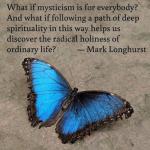In chapter five of his book Buddha Is as Buddha Does, dharma teacher Lama Surya Das offers this fascinating insight into the nature of mindfulness:
According to Tibetan Buddhist tradition, there are four kinds of mindfulness. First comes average mindfulness—the attention that springs naturally and spontaneously through our own interest in a particular person, situation, or phenomenon. For the most part, it’s concerned with worldly matters and lasts as long as the interest itself. The second kind is cultivated or generated mindfulness—the type that we intentionally apply to particular objects of awareness in order to stabilize or deepen our understanding of them. This can be considered the general practice of mindfulness: a highly focused and alert presence of mind free from judgment, evaluation, reactivity. The third kind is abiding mindfulness: the well-trained mind is sufficiently tamed to rest naturally, without wavering, wherever it is focused. Accomplished meditation masters can sustain this kind of concentrated or one-pointed mindfulness for hours, days, or even longer, uninterrupted by distractions. The fourth is Dharmakaya mindfulness, or innate wakefulness, where awareness itself remains undistracted from its own nature. In other words, there is no observer “I” noticing awareness within our consciousness, nor can anything within or outside our consciousness diffuse its energy.
As I’m reading these words, I am reminded of the four different human consciousness which are measured by the length of our brain waves:
- Beta (13‐20 Hz): Ordinary waking consciousness. Brain waves at this frequency are present when we are alert and concentrating on our activities: driving, reading, solving a math problem, engaged in stimulating conversation.
- Alpha (8‐13 Hz): Relaxed consciousness. Still awake and perhaps also alert, but less concentration and more open awareness. This frequency marks relaxation, meditation, getting a massage, taking a slow walk in the forest.
- Theta (4‐8 Hz): Creative consciousness. With these slowing brainwaves we move into the deeply open space of dream, daydream and reverie. This is the twilight space where intuition kicks in and ideas flow naturally. Perhaps this is the forum where mystical experience and consciousness of divine presence is most likely to occur.
- Delta (±0 to 4 Hz): Deep dreamless sleep. As our mind powers down to very slow brain waves, we simply experience a lack of awareness that typically includes most of the night of a good night’s sleep (but when we dream, we return to theta waves).
Lama Surya Das’s fourfold model of mindfulness does not track exactly with brainwaves, since mindfulness does not typically include deep sleep, so delta waves don’t really show up in his model. But it’s important to remember he is presented traditional Tibetan Buddhist teachings, which are not meant to be a type of scientific classification. Still, I can see some interesting parallels.
- Average Mindfulness might correspond with high alpha or low beta states: it’s the ordinary experience of “paying attention” to something, without effort, and for only as long as the object of attention remains interesting. Average mindfulness flits about like a hummingbird flying from flower to flower seeking nectar.
- Cultivated Mindfulness might correspond to the higher range of beta consciousness: here we are more intentionally “showing up” with focused awareness, as we seek to learn something, master a skill, or cultivate greater understanding. We’ve slowed down the flitting hummingbird and our putting effort into keeping our mindfulness focused on a single object of interest.
- Abiding Mindfulness, the fruit of a stable meditation practice, takes us into the low alpha to theta range. This is the adept attentiveness to what Cynthia Bourgeault calls “objectless awareness,” requiring less effort than cultivated mindfulness, because it is the fruit of years if not decades of practice. Here we simply relax into open, spacious, wordless being, and once there we seek to simply rest in the sacred now.
- Dharmakaya Mindfulness — dharmakaya literally means “wisdom-body” and so it implies a mindfulness which is the embodiment of all wisdom. As Lama Surya Das suggests, this is nondual mindfulness. I have no idea which brainwaves correspond to this, but I imagine the deepest theta state comes the closest. This is the page of consciousness on which the words of awareness are printed. This is enlightened consciousness, and a western/theistic understanding might see this as the consciousness of nondual divine union, complete objectless awareness where the “I” drops away and all that is present is divine consciousness.
So let’s take these two ways of mapping consciousness and apply them to Centering Prayer.
- Centering Prayer, especially at first, is an invitation into relaxed awareness of silence but that often results in a frustrating experience of distracting thoughts and using one’s sacred word to return to the silence. Here the “goal” is abiding mindfulness, but we start by dancing between average mindfulness (the distracting stream of ordinary consciousness) and cultivated mindfulness (the effort to keep returning to silence awareness through your sacred word).
- Over time and persevering in practice, little by little the experience of abiding mindfulness can occur. This is an experience of grace: we cannot force or engineer abiding mindfulness, we simply allow it to occur and bask it in when it does. Often, especially at first, the radical openness of abiding mindfulness is so sweet that we almost immediately pop back into average mindfulness, with a thought like, “Isn’t this awesome? I’m finally getting somewhere with my meditation!” Oops! And the cycle begins again.
- Finally, the experience of dharmakaya mindfulness is even more elusive than abiding mindfulness, for this is a pure gift of grace. It is what the classic mystics called “infused contemplation” (whereas abiding mindfulness is “acquired contemplation”). It is “infused” by the Spirit, a grace given, not something we control. But when it shows up, we cay say (echoing Dainin Katagiri) that “each moment is the universe” — a single split second of dharmakaya mindfulness is an opening-up into the timelessness of eternity and the all-pervasive bliss of limitless non-dual grace.
It is generally believed that Centering Prayer needs to practiced with an open mind and open heart, which is to say, with no “goal” other than being present and consenting to the action of the Spirit within us. But perhaps we can be excused for saying that another reason for an ongoing practice of Centering Prayer is to make ourselves available for the gift of infused contemplation/dharmakaya mindfulness.
Since Centering Prayer is a western, which is to say theistic, meditation practice, it’s wise to view it as a dance of the human creature with the divine creator. We enter the silence to consent to the Spirit’s presence and action within. Therefore, exploring the different levels of consciousness or kinds of mindfulness is not an end to itself, but always a means to an end: ever-opening availability to deeper intimacy with God. Perhaps the four dimensions of mindfulness are like four mansions in the Interior Castle, each one bringing us closer to that place where all dualities and all away and there is only the bliss of union with God.















